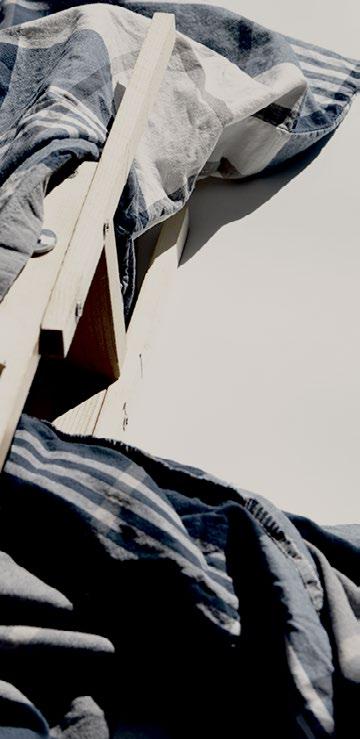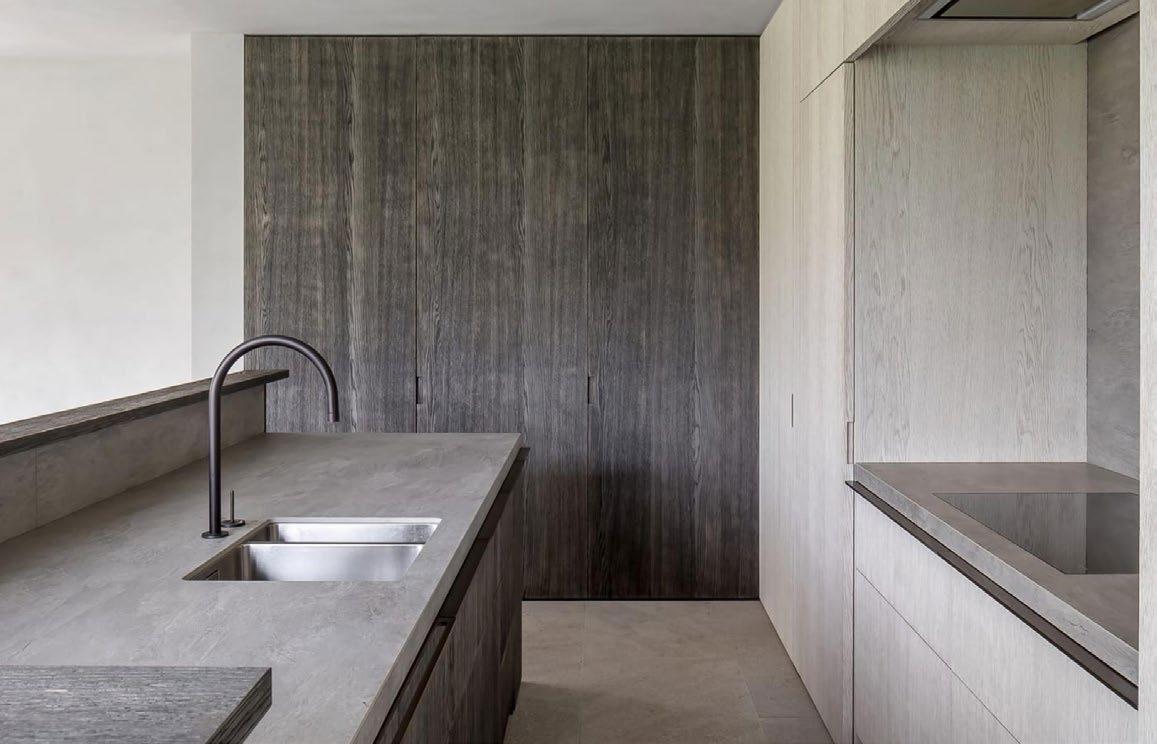YOU CAN Make It
Intro & Skills
With this thesis, I graduated from high school with high distinction. The product I created is a tool that assists people in making their bed. This task can be burdensome, tiring, and above all, very frustrating, which makes the product useful for everyone. In this chapter, I would like to demonstrate how it works.
The skills I developed during this project included graphic design, market analysis, and human centered research targeted at a specific audience (in this case: elderly individuals). However, the most crucial skill was effective communication, utilizing brainstorm sketches and scale models to present and discuss the outcomes with a persona, as well as defending my work in front of a jury.
photographer: Marianne Krohn


Testing is knowing

I noticed during the first tests that fixing the bedsheet opening is enough to simplify making your bed. In these pictures, you can see how the clamp locks the opening of the bedsheet in place. This way, your hands, while inside the sheets, are free to reach the far corners and pull them through the fixed opening, turning the sheet inside out.
Now you keep the clamp fixed so you can reverse these steps. While again, grabbing the corners of the sheet from the inside, you can also grab the corners of your duvet on the outside. Pull the corners and the duvet through the frame so that the duvet turns inside the sheet. Remove the frame and tuck in the lower corners of your duvet. This system simplifies the effort and reduces clumsiness while making the bed.
After a lot of tests on different clamps and fixation systems, I opted for the most universal solution. Considering the wide variety of beds, mattresses, and slatted bases, the mattress cover is the most common feature. So, this is what I wanted to fixate the sheet’s opening to.
Clamping it together was still a tough nut to crack. Eventually, I came up with a bolt that could slide into a nut, locking them together with a 90° twist instead of having a normal threaded bolt & nut. This made the clamp’s axial movement faster and more ergonomic.



“Do it with passion or not at all” Rosa Nouchette Carey
Final result
With the system of the first test in place, I’ve done my very best to make the product as small, universal, and as user-friendly as possible.
The way it works is, each ball fixates a side of the sheet’s opening to the mattress cover. fixating the sheet’s opening so you can easily pull it inside out; making the whole process a lot easier and less clumsy.

I’m very proud of the system I’ve invented, but if I could redesign the product, I would. By trying to make it a universal tool, the efficiency took a blow. The redesign would be attached to a fixed base instead of the mattress cover, making it more user-friendly.
Despite the flaws, my thesis has received a lot of positive feedback. One day I will finish this project, making it a “musthave” tool because nobody likes to change their sheets. ;)

Obsee Glasses

Styling
The objective of the following project during the course “Advanced surfacing” was to learn the surfacing features of the CAD program Siemens NX. Using different inspiration boards, lots and lots of shape explorations, sketches, and endless CAD drawings, we learned once more to adapt to a curtain style while designing something new.
As you can see in the background of this page, I used this course to design a pair of glasses. Starting with the creation of inspiration boards and brainstorming sketches, I followed up by determining the ergonomic measurements through in-depth research of different indexes, papers, and also measuring every pair I could find at home. With the measurements and the design figured out, I created a CAD model, printed it, sanded it smooth, and finally gave it a nice spray tan.
Inspiration

Different inspiration boards help to understand a certain aesthetic value of a design. The pictures to the right are each a single fragment of one of the boards to give a global sense of the design language.
To gain a deeper understanding, we would use a few key words to define the inspiration. For the glasses, my words were:
Essential, Distinguished, Classic, Honest
The basic shape I used to design the frame was found in a basement in the form of an old water well. The square forming the opening had slightly curved sides, which gave the simple geometry a profound look.
detail of the mood-board


 detail of the style-board
detail of the CMF-board
detail of the style-board
detail of the CMF-board
Final result
The eventual product would be realized from cellulose acetate slabs that are CNC milled into shape. Acetate is a popular choice for glasses, so my choice isn’t exactly groundbreaking. I chose this material after the shape was designed, simply because it was the only possible choice.

The picture you see on the right is the final prototype of the model I made for the presentation. The 3D printed frame is completed with two lenses I cut from PMMA and bent into shape.
To top it off, I made a matching casing based on one I made from wood in a previous project. You’ll find this project on my Behance page. I created this casing out of frustration with common casings that always break at the hinges, which is just idiotic. Ironically, the wooden case I made broke rather quickly as I didn’t take into consideration the grain of the wood. The 3D printed version was a lot stronger and is still in use today.

Nosce te ipsum

Intro & Skills
The idea of Nosce came forth out of the course “strategic industrial design” (SID) where we focused on the why-question before anything else. Personally, I prefer this manner of reasoning since it makes sure that the work you are doing is, in fact, worth doing. For this project, we started by formulating a specific problem considering burnout patients.
A specific skill I learned from this group project was field research, for which we called a number of psychologists and interviewed people active in industries known for the number of burnout patients, such as teachers, principals, and nurses. Only after we gathered enough information about the problem at hand, we began to search for solutions, asking the stakeholders for feedback.

To define a real problem

To design a solution, we first had to formulate the problem by bundling all the information we gathered.
A burnout patient needs an environment where they can recharge. They require a place to sit alone with their thoughts, an environment where negative external stimuli are excluded. The use of natural elements can play a role in creating a comfortable atmosphere where the worries of everyday life can be momentarily forgotten. With the hope of developing a product that aids in this process, we can initiate a faster recovery, allowing the patient to resume their daily life as desired.
We conducted a market segmentation in which we clustered the current methods of stimulating calmness. Among these clusters, we chose to focus on sensory therapy as it showed the highest potential for developing into a product. We soon realized that with VR, we could tailor the sensory input of vision as well as sound to each individual.






Our salution
We aimed to create a serene space for self-reflection and relaxation, away from all external stimuli that encourage stress. However, our primary focus is to stimulate individuals to delve into the root cause of their burnout issues in order to find effective solutions.
We chose to work with Virtual Reality (VR) technology to create a room where external disturbances are eliminated. Within this virtual room, individuals can engage in introspection without any external distractions.
The eventual product would be based on the fact that the recovery process of burnout patients often involves writing down their experiences and thoughts. So we developed a writing tablet that seamlessly connects to the VR world as the main controller. Our product lineup includes a writing tablet, a magnet to clip a real piece of paper onto the tablet, meaning you take your notes digitally and simultaneously in real life, and a smartpen with real ink, accompanied by PC and VR applications so that the process can be monitored and guided by an expert.
To make a long story short, we made a tablet that a burnout patient can use in a calming VR world to reflect and write down their thoughts and realizations, which can later be discussed with a psychologist.

Îlot de ballet
Intro & Skills

With this thesis, I earned my professional bachelor’s degree and graduated from Howest College with honors. Together with Villa Interno, a company that designs luxury interiors and kitchens, we created an outdoor kitchen module. To start the project, I had several consultations with the CEO, Filip, to determine the needs of his target audience.
The target group consists of prosperous individuals aged 45 and above with a desire for a luxurious minimalist interior where a sense of security leads to a pleasant space for social interaction. A kitchen that excels in efficiency, is easy to keep clean, and looks just as good after 20 years. Sleek in design, finish, and maintenance.


Storage zone, Stock zone, Rinse zone, Work zone, Cooking zone

research
The elementary design of a kitchen isn’t hard. The basic principle starts with the kitchen triangle. This states that most interaction in a kitchen occurs between the refrigerator, sink, and stove. However, the work triangle is concise. To specify the layout of a kitchen, we divide it into zones and ensure there is enough storage space.
Inspired by Boffi’s mini kitchen, Villa Interno would like to create its own modular island specifically designed for outdoor use. One of the biggestchallenges we encounter is the unpleasant walking distance from the kitchen to the garden. Therefore, the outdoor unit should provide the user with seamless communication between the indoor kitchen and itself.

The Functionallity
Due to the arrangement and subdivision of the drawers, there are various applications possible during the cooking process. By incorporating gastronorm containers into the module, the island has its own trays for direct interaction with the indoor kitchen. They are measured for their unique purposes and minimize the number of trips necessary as the organization gives a clear overview.
The four trays are assigned to do the following:
GN 1/1: Fill this tray with Utensils & ingredients and use it to later store the dishes, keeping your worktop clean.
GN 1/4: This tray is used for rags and soapy water to clean while cooking.
GN 1/4: This tray is used as a bin for organic waste.

GN 2/4: This tray is to serve as an ice bucket, making sure the drinks stay cool inside the drawer.
Since the modules are produced on request, various customizations are possible, such as the color of the metal coating or the type of stone, as well as the type of cooking equipment. The module is made for the Miele smart line, which offers the choice between a teppanyaki, a wok, and a simple stovetop. These modules have the same built-in size, making it ideal as a custom part.


The philosophy
The name “Îlot de ballet” is derived from the combination of “îlot de cuisine,” meaning kitchen island, and “ballet” due to its resemblance to the “deuxième position” in ballet.
“Îlot de ballet” as a standalone object is designed to create its own space, rather than blending into the existing space. We differentiate how a ballerina, while tiptoeing gracefully, spins within her own defined space, while a sleeping cat effortlessly becomes a part of the furniture.




 Photographer: Stéphanie Swinnen
Photographer: Stéphanie Swinnen
 Design: Maarten Jonckheer
Design: Maarten Jonckheer












 detail of the style-board
detail of the CMF-board
detail of the style-board
detail of the CMF-board























